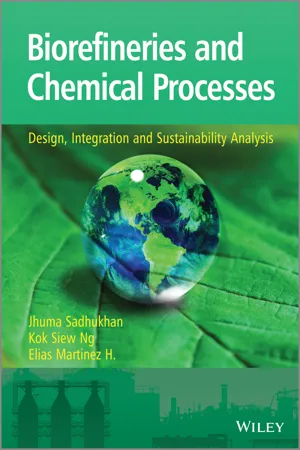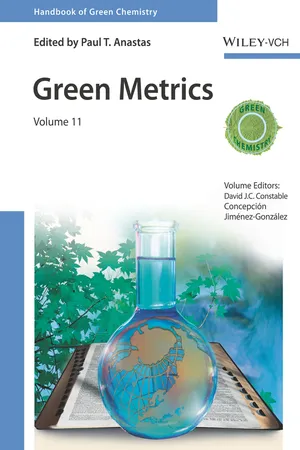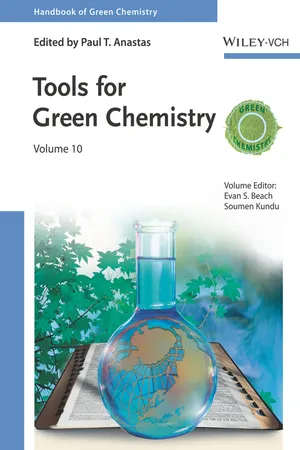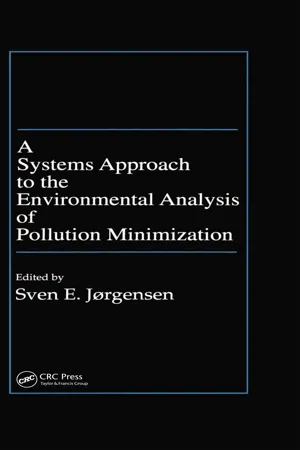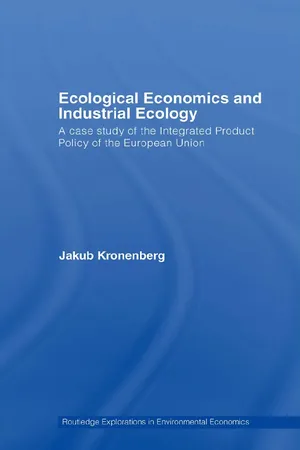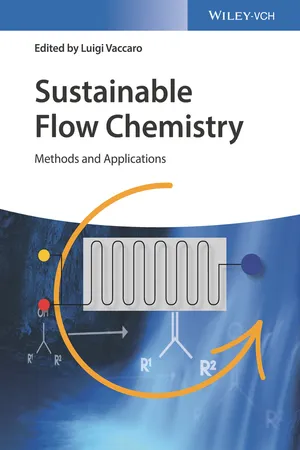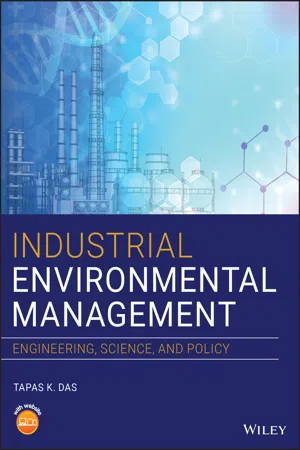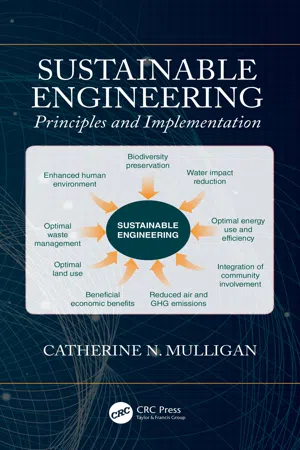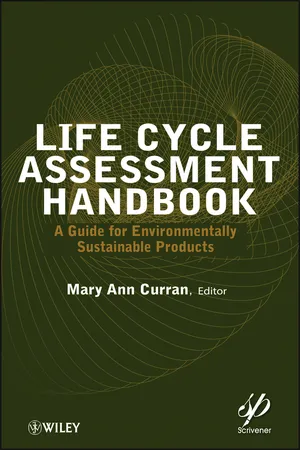Chemistry
Life Cycle Assessments
Life Cycle Assessments (LCA) are a method used to evaluate the environmental impacts of a product or process throughout its entire life cycle, from raw material extraction to disposal. It considers factors such as resource use, energy consumption, and emissions to assess the sustainability of a product or process. LCA helps identify opportunities for improvement and informs decision-making for more sustainable practices.
Written by Perlego with AI-assistance
Related key terms
Related key terms
1 of 4
Related key terms
1 of 3
11 Key excerpts on "Life Cycle Assessments"
- eBook - ePub
Biorefineries and Chemical Processes
Design, Integration and Sustainability Analysis
- Jhuma Sadhukhan, Kok Siew Ng, Elias Martinez Hernandez(Authors)
- 2014(Publication Date)
- Wiley(Publisher)
3 . The impacts of pollutants turned out to be more severe than estimated. The majority of chemicals is related to one or more categories of environmental pollutants. Understanding the impacts of chemicals under various environmental categories or characterizations can help identifying and eliminating them at their sources, if possible at the first instance. If not, chemicals must be treated and regulated before their discharge to the environment.By the mid-1980s the multicriteria systematic analysis had spread to include many more products. Different terms were used to describe these studies, the term Life Cycle Assessment was proposed and agreed upon at a workshop held by the Society of Environmental Toxicology and Chemistry (SETAC) at Vermont, USA, in 1990. SETAC have since published various guides and advice material on LCA simplification and methods.The definition of Life Cycle Assessment as given by the International Organization for Standardization (ISO) in 1997 is:Compilation and evaluation of the inputs, outputs and the potential environmental impacts of a product system throughout its life cycle.According to ISO standards 14040, 14041 and 14044, the LCA is carried out in four phases: Goal and Scope definition, Inventory analysis, Impact Assessment and Interpretation4–6 . All these phases are interdependent as a result of one phase determining the execution of the next phase. Figure 4.5 shows the different phases involved in an LCA study. Figure 4.6 - eBook - ePub
- Paul T. Anastas, Paul T. Anastas(Authors)
- 2018(Publication Date)
- Wiley-VCH(Publisher)
4 Life Cycle AssessmentConcepción Jiménez-González4.1 Introduction
Life cycle inventory and assessment (LCI/A) is a methodology that allows one to estimate the cumulative environmental impacts associated with manufacturing the chemicals, materials, and equipment used to make a product or deliver a service, thereby providing a comprehensive view of the potential trade-offs in environmental impacts associated with a given activity. The term life cycle refers to the major phases of a process or product, from the extraction of all raw materials to the final manufacture, transportation, use, maintenance, reuse, to its final fate [1,2].Depending on the objectives of the assessment, the life cycle evaluation of the environmental impacts is likely to have different boundary conditions [3,4]. For instance, it could cover the entire supply chain (cradle-to-grave, or CtG), a single chemical plant (gate-to-gate, or GtG), or downstream production impacts. Life cycle metrics can either be- direct life cycle inventory (LCI) data, for example, life cycle energy, life cycle mass, life cycle emissions;
- or, they could come from a life cycle impact assessment (LCIA), which measures either individual impacts, such as global warming potential, or aggregates the impacts into a score or index, such as the EcoIndicator 99 method [5].
Life cycle thus provides a framework of more holistic “green metrics” to estimate the environmental footprint of a route, process, or reaction. The use of LCI/A to measure the “greenness” of chemistries has been championed previously elsewhere as a strategic need in the development and use of green metrics [6–11]. Using a life cycle approach to estimate environmental impacts of processes and products provides the practitioner with the following advantages: - eBook - ePub
- Evan S. Beach, Soumen Kundu, Paul T. Anastas, Evan S. Beach, Soumen Kundu(Authors)
- 2017(Publication Date)
- Wiley-VCH(Publisher)
1 Application of Life Cycle Assessment to Green Chemistry ObjectivesThomas E. Swarr, Daniele Cespi, James Fava, and Philip Nuss1.1 Introduction
Green chemistry (GC) is described by the 12 principles of green chemistry to guide the design of chemical products and processes that reduce or eliminate the generation and use of hazardous substances [1]. The guiding principles have been criticized for being qualitative and failing to provide an objective means to assess the overall “greenness” of proposed solutions or to evaluate trade-offs among conflicting principles, for example, reduced toxicity, but increased energy consumption [2]. Life cycle assessment (LCA) is the “compilation and evaluation of the inputs, outputs, and the potential environmental impacts of a product system” and provides a quantitative method to address these concerns (3], p.2). It is an international standard recognized as an effective methodology to evaluate improvement strategies and avoid shifting problems to other times and places or among various environmental media [4,5].LCA, however, has its own set of limitations and unresolved methodology issues [6,7]. Some are particularly relevant to green chemistry, such as limited data for chemical production chains, lack of geographic specificity, and aggregation of emissions over time [8–10]. Increasingly, researchers are recognizing that the strengths and weaknesses of GC and LCA are complementary and are advocating for more effective integration of both methodologies to develop more sustainable solutions [2,11,12]. Anastas and Lankey (11], p.289) broaden the definition of green chemistry by considering chemistry to include “the structure and transformation of all matter” and hazardous impacts to address the “full range of threats to human health and the environment.” Application of LCA to GC problems promises a better understanding of the flow of toxics through the economy and provides a robust framework for organizing knowledge about inherent hazards associated with product systems [13]. - eBook - ePub
- Robert Crawford(Author)
- 2011(Publication Date)
- Routledge(Publisher)
3 Life cycle assessment
There are many types of tools and techniques available for improving and managing environmental performance, each of which provides a unique approach to assessing and potentially identifying strategies for improving the environmental performance of a wide range of products, processes and services. Life cycle assessment (LCA), also known as life cycle analysis or cradle-to-grave analysis, is a more recent addition to these tools, and aims to support an increasing focus towards environmental improvement and management. Life cycle assessment is distinct in that it takes a more holistic approach to environmental assessment, considering a broad range of potential impacts, and as the name suggests, across every stage of a product's life. Another benefit of LCA is that it is based on a chosen functional unit and can factor in many geographic, technological and temporal variations in its assessment.This chapter provides an overview of life cycle assessment and a description of the various components of a life cycle study, including its various uses and limitations. The various methods of obtaining environmental data are described in detail and the limitations of each of these methods are explained. Particular emphasis is placed on this aspect of an LCA as this phase is the most crucial in ensuring that eventual outcomes of any LCA study are as reliable and useful as possible.3.1 What is life cycle assessment?
Life cycle assessment is a tool that is used to determine and evaluate the environmental loadings and impacts of a particular product or process, including those effects associated with processes upstream in the supply chain (Curran 1993). LCA is used to analyze these loadings over the entire life cycle of the product or process being studied, from the extraction of raw materials from the ground to final disposal or recycling of the product at the end of its useful life. The environmental impacts across the life cycle of any product or process can be linked to the relevant inputs and outputs of the product system. These inputs and outputs include the raw materials extracted from the earth; energy and water use; emissions to air, land and water; solid wastes; co-products; and other releases, as shown in Figure 3.1 - Sven E. Jorgensen(Author)
- 2020(Publication Date)
- CRC Press(Publisher)
9Life Cycle Assessment — Environmental Assessment of Products
Michael Hauschild Henrik Wenzel CONTENTS 9.1 What Is Life Cycle Assessment? 9.1.1 Introduction — The Life Cycle Perspective 9.1.2 The History of Life Cycle Assessment 9.1.3 The Interested Parties of LCA 9.1.4 International Coordination of LCA Method Development and Standardization 9.2 How to Perform an LCA 9.3 Goal Definition and Scoping 9.3.1 Goal Definition 9.3.2 Scope Definition 9.4 Inventory Analysis 9.4.1 Collection of Data 9.4.2 Quality of Data 9.4.3 Use of Computer Tools and Databases 9.5 Impact Assessment 9.5.1 Classification 9.5.2 Characterization 9.5.3 Normalization 9.5.4 Weighting 9.6 Interpretation 9.7 Reporting and Critical Review9.1 What Is Life Cycle Assessment?
Life cycle assessment is a methodology for assessing the environmental impacts and resource consumptions associated with the existence of products throughout the entire life cycle of the products — from cradle to grave. A central characteristic of life cycle assessment is thus the holistic focus on products (or the functions they fulfill) rather than on individual processes.9.1.1 Introduction — The Life Cycle Perspective
The last decade of the 20th century has seen the emergence of a strong interest in the environmental impacts associated with the products that surround us and by which we obtain the many services that our civilization relies on. This interest has been accompanied by the development of methods for environmental assessment of products. Other environmental assessment schemes, such as environmental risk assessment of chemicals (ERA, see Chapter 10- eBook - ePub
Green Composites
Polymer Composites and the Environment
- Caroline Baillie, Randika Jayasinghe(Authors)
- 2004(Publication Date)
- Woodhead Publishing(Publisher)
3Life cycle assessment
R. Murphy Imperial College London, UK3.1 Introduction
Awareness that human activities can damage the Earth’s capacity to sustain life has been growing since the publication of Rachael Carson’s book Silent Spring in 1962 and the Club of Rome’s The Limits to Growth in 1972 (Meadows et al., 1972). More recently, the concepts of Sustainable Development (The World Commission on Sustainable Development, Brundtland, 1987 ) and Industrial Ecology (see Frosch and Gallopoulos, 1989 ) have emerged to help guide ways in which human society can be organised so that this capacity is preserved. Assessment of the environmental impact arising from activities such as construction, packaging or transport is an essential activity when attempting to design sustainable approaches to our development needs. A number of tools are now available for such assessments. Amongst these, life cycle assessment (LCA) has emerged over the last 10 to 15 years as a widely respected technique for evaluating the environmental aspects associated with a wide variety of products, processes or activities throughout their entire life cycles.3.1.1 Life cycle assessment
LCA is a systems analysis tool for evaluating environmental impacts over the whole life cycle of a product, process or activity from the ‘cradle’ (raw material acquisition) to the ‘grave’ (disposal or recycling) (UNEP, 1996 ; ISO, 1997 ). The emphasis in LCA is to generate transparent and complete assessments of environmental impact resulting from all stages of the life cycle of the product or activity in question and to use this to evaluate its environmental attributes in a holistic way. This approach has the potential to avoid mistakes or distortions engendered by ‘single issue’ or ‘single focus’ environmental assessments.LCAs are being used in fields as diverse as construction, energy systems, composite materials, packaging, agricultural production and green chemistry amongst others (Marteel et al., - eBook - ePub
- Jakub Kronenberg(Author)
- 2007(Publication Date)
- Routledge(Publisher)
1 Now, as a result of that broad interest, LCA has become probably the most established tool of industrial ecology.According to SETAC, LCA can be defined as follows.The life-cycle assessment is an objective process to evaluate the environmental burdens associated with a product, process, or activity by identifying and quantifying energy and material usage and environmental releases, to assess the impact of those energy and material uses and releases on the environment, and to evaluate and implement opportunities to effect environmental improvements. The assessment includes the entire life cycle of the product, process or activity, encompassing extracting and processing raw materials; manufacturing, transportation, and distribution; use/re-use/ maintenance; recycling; and final disposal.(Graedel and Allenby 1995: 108)More concisely, ISO standards describe LCA as a ‘compilation and evaluation of the inputs, outputs and the potential environmental impacts of a product system throughout its life cycle’ (ISO 2006a: clause 3.2). Thus, an LCA can serve to identify places in the life-cycle of a product where the most significant environmental improvement can be achieved. Also, it can be used to describe and, under numerous conditions, to compare different products with regard to their environmental performance throughout the whole life-cycle. In the former sense, performing an LCA resembles launching a search for leverage points (optimization of products’ environmental performance). The latter is possible through the application of functional thinking and the definition of a functional unit, which will be introduced in the following subsection. I then move on to the presentation of the LCA procedure and its applications; finally, I review some of the limitations of LCA as it is currently practised. - eBook - ePub
Sustainable Flow Chemistry
Methods and Applications
- Luigi Vaccaro(Author)
- 2016(Publication Date)
- Wiley-VCH(Publisher)
Clearly, the reduction in capital cost of equipment will correlate with the reduction in materials used for construction of the reactors, which should translate into a reduction in environmental impact of the reactor technology. However, this hypothesis requires proof by way of evaluation of the life cycle impacts of the manufacture of the new types of reactors. Similarly, from the chemistry perspective, development of flow processes in some cases requires a larger use of solvents compared to the corresponding batch processes, due to the need to keep all reactants/products/by-products in the solution phase to prevent reactor blocking over time. The increased use of solvents will result in worse environmental impacts, but this may also depend on the boundaries of assessment and other changes made within the process.In this chapter, we introduce the framework for evaluating the environmental sustainability. The most appropriate methodology for evaluation of environmental sustainability of chemical processes is life cycle assessment (LCA). Arguments in favor of LCA as opposed to single indicators or a collection of indicators into metrics, evaluated within a narrow system boundary, will be presented. A number of case studies will be presented to demonstrate the application of LCA in the development of continuous flow processes.10.2 Environmental Sustainability Assessment
Sustainability is frequently represented by a three-pillar model, that includes environmental, social, and economic aspects [17]. Evaluation of the environmental factors is the most developed set of methodologies, which takes the form of either a defined set of metrics, such as AIChE or IChemE metrics [18, 19] or follows the LCA methodology as outlined in ISO 14040/14044. The most important question in environmental sustainability assessment is that of the boundary of assessment: if we consider a synthetic chemical route, how far upstream should we start – from the most common commercially available precursors or from raw materials? This question is otherwise phrased as defining the scope - eBook - ePub
Industrial Environmental Management
Engineering, Science, and Policy
- Tapas K. Das(Author)
- 2020(Publication Date)
- Wiley(Publisher)
A second method to reduce data collection time and resources is to obtain non‐site specific inventory data. Several organizations have developed databases specifically for LCA that contain some of the basic data commonly needed in constructing an LCI. Some of the databases are sold in conjunction with LCI data collection software; others are stand‐alone resources. Many companies with proprietary software also offer consulting services for LCA design.6.2.4.4 Step 4: Evaluate and Document the LCI Results
When the data have been collected and organized, the accuracy of the results must be verified. In documenting the results of the LCI, it is important to thoroughly describe the methodology used in the analysis, define the systems analyzed and the boundaries that were set, and state all assumptions made in performing the inventory analysis. Use of the checklist and worksheet (see step 2) supports a clear process for documenting this information. The outcome of the inventory analysis is a list containing the quantities of pollutants released to the environment and the amount of energy and materials consumed. The information can be organized by life cycle stage, by media (air, water, land), by specific process, or any combination thereof that is consistent with the ground rules.If the sensitivity of the LCI data collection efforts has not been properly determined before the next stage, life cycle impact assessment (LCIA), is begun, the LCA itself may have to be repeated because the data are found to be insufficient to permit the drawing of the desired conclusions.6.2.5 Life Cycle Impact Assessment
The LCIA phase is the evaluation of potential human health and environmental impacts of the environmental resources and releases identified during the LCI. Impact assessment should address ecological and human health effects; it can also address resource depletion. An LCIA attempts to establish a linkage between the product or process and its potential environmental impacts. For example, an LCIA could determine whether one product or process causes more GHGs than other, or could potentially kill more fish.The key concept in this component is that of stressors. A stressor is a set of conditions that may lead to an impact. For example, if a product or process is emitting GHGs, the increase of GHGs in the atmosphere may contribute to global warming. Processes that result in the discharge of excess nutrients into bodies of water may - eBook - ePub
Sustainable Engineering
Principles and Implementation
- Catherine Mulligan(Author)
- 2019(Publication Date)
- CRC Press(Publisher)
Ecoinvent (2007) is an international database containing thousands of datasets. The latest version 3.4 was released in October 2017. New data have been added for supply chains in the natural gas sector, chemical products, the electrical sector, and recycling of plastics.3.5 Applications of LCA
The main applications for LCA have been in the process and manufacturing industries. It can examine the stage of the life cycle that can cause the most damage to the environment such as greenhouse gas emissions. It can also apply to services such as waste management, buildings and infrastructure, and even organizations where many products are made in different or single facility. ISO 14072 gives some guidance for organization on how to apply ISO 14040 and ISO 14044 for organizations. LCA are increasingly being implemented particularly for greenhouse gas emissions. Most assessments, however, include only emissions of CO2 , CH4 , and N2 O. Some applications of LCA are described below.Caruso et al. (2017) examined the use of LCA for buildings. LCA can be done for each component. However, this does not take into account the links between the components. They examined residential buildings with three different structural materials for the design option. The ISO 14040 and ISO 14044 procedures were used for the environmental LCA. The steps included goal and scope definition, LCI, LCIA, and results. The life cycle of cement manufacture is shown in Figure 3.8 . The reinforced concrete (RC), steel and wood structures were compared. The boundaries of the case study are shown in Figure 3.9 .SimaPro was used for collecting and analyzing the sustainability of products and services. Ecoinvent 2.2 international database was employed for the LCI and IMPACT2002+ methodology and Environmental Product Declaration (EPD) methodology for the impact assessment. The results showed that the RC option was a viable option. It had the highest impact for climate change but lower than the others for other categories throughout the entire life cycle. No option was ideal in all categories. - eBook - ePub
Life Cycle Assessment Handbook
A Guide for Environmentally Sustainable Products
- Mary Ann Curran, Mary Ann Curran(Authors)
- 2012(Publication Date)
- Wiley-Scrivener(Publisher)
Table 11.2 provides a comparison of the components contained in an LCA versus a GHG inventory and EPA’s MRR accounting of GHG emissions. For LCA, the approach is focused on the burden (present and future) associated with the management of a given tonnage of waste generated. Most waste management related burdens are more or less instantaneous, except for landfills where burden accrue over a long period of time. For landfills, in an LCA the waste-in-place approach isn’t used but rather a time series is. For example, if 100 tons of waste were landfilled, the approach per LCA would be to estimate the emissions that would be produced by the 100 tons of waste during a future timeframe (100 years is typical).Table 11.2 Comparison of LCA, GHG inventory, and US EPA GHG MRR scope.11.4 Summary of Key Life Cycle Procedures and their Application to End-of-Life Systems
LCA is typically thought of as a technique for assessing the environmental aspects and potential impacts of a system from raw materials acquisition through production, use, and disposal. According to the internationally accepted ISO 14040 standards, conducting an LCA includes compiling an inventory of relevant inputs and outputs of a system, evaluating the potential environmental and health impacts of those inputs and outputs, and interpreting the results in relation to the objectives of the study. LCA provides a systematic and standard methodology for characterizing the environmental aspects and potential impacts of waste management alternatives. Figure 11.2 shows an example of a life cycle flow diagram for waste. The methodology for conducting the LCA for waste management alternatives includes all stages of the waste life cycle and is based on the mass flow of materials and energy in and out, emissions, and associated impacts of the different unit processes included within the life cycle.Figure 11.2Life cycle diagram for waste management.The life cycle concept and more formal LCA have evolved through an increasing awareness that a comprehensive view of production systems leads to environmentally friendly design and decision-making. The ISO14000 standards provide requirements and recommendations in terms of what an LCA should include, they provide little direct guidance for handling issues specific to waste management. Ultimately application of the guidelines recognizes that the actual methods used and level of detail employed varies by study In general, the goals of the LCA drive the level of complexity and detail required in the study. The most rigorous level of detail is required for cross-product (e.g., paper versus plastic grocery bags) or cross-process (e.g., recycling versus landfill) comparative assessments.
Index pages curate the most relevant extracts from our library of academic textbooks. They’ve been created using an in-house natural language model (NLM), each adding context and meaning to key research topics.
Explore more topic indexes
Explore more topic indexes
1 of 6
Explore more topic indexes
1 of 4
